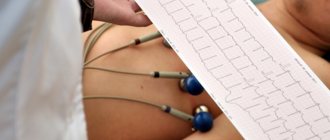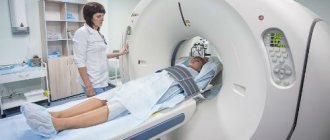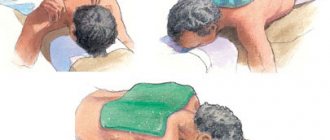What parents should pay attention to
As mentioned just above, reasons for concern when a child has pain in the heart area may not only be cardiac diseases. Pay attention to how often your child's pain occurs and how long it lasts. Observe whether there is shortness of breath after vigorous physical activity.
It is advisable to take the pulse at the moment when the child complains of chest pain, and also ask if anything else is bothering you.
If you notice any unusual changes in your baby’s behavior, be sure to inform the doctor at your appointment. The child may not immediately contact the doctor, so it is worth finding out in advance what is bothering your child.
Chest pain due to sprains, intercostal neuralgia and injuries
With intercostal neuralgia, which manifests itself as a result of muscle spasm, the nerve roots are compressed, and a sharp pain occurs in the chest, radiating to the back.
Chest pain can also be caused by damage to the pectoral or back muscles - sprains, tumors (rhabdomyoma), inflammation (myositis).
Pain from bruises, fractures or cracked ribs can also be mistaken for heart pain. However, by the location of the source of pain, it can be determined that it is not the heart that is hurting.
If you have chest pain or heart pain, contact our clinic. Experienced doctors will make the correct diagnosis and prescribe a course of treatment.
Causes of pain in the heart area
Among non-cardiac reasons:
- diseases of the spine;
- diseases of the gastrointestinal tract - the child has pain in the heart area due to irradiation of pain from the stomach;
- vegetative-vascular dystonia;
- emotional experiences;
- neurological disorders, etc.
If we talk about diseases of the heart and blood vessels, the reasons may be:
- myocarditis;
- endocarditis;
- pericarditis;
- rheumatism;
- aortic aneurysm, etc.
There is no need to panic - the best thing you can do is to go to a specialist as soon as possible.
How dangerous are tingling sensations in the heart?
Natalia Denisova
August 19, 2016
Lately my heart has been pounding very often, so much so that I really thought that a heart attack was inevitable. Of course, when this started to bother me more than once every six months, I turned to my therapist. The doctor immediately asked what kind of pain in the heart area was bothering me. Then I thought: why in the region? I feel that this heart is probably pinching something in this muscle, or maybe, in general, something with the valves.
As a result of an incredibly educational conversation for me, it became clear that stabbing pain on the left often does not touch the heart at all, because this type of ailment is not typical for this organ. Now, if the pain is pressing, burning or pulling, you need to run to the doctor as soon as possible, because such signals from the body sometimes indicate a great danger to your life. For example, the first signs of a heart attack and angina are pressure and burning chest pain, nausea and even vomiting. In this case, it is better to take nitroglycerin and call an ambulance. Heart failure is also characterized not by tingling of the heart, but by shortness of breath, increased fatigue, lips, as well as fingers and toes become very pale or even with a blue tint. Well, stabbing pain can occur for a huge list of reasons; of course, you shouldn’t ignore them either, but go to a therapist, who, after listening to you, will send you to the right doctor. The most important thing is not to think that it will go away soon, but to try to find out the cause of the pain. As you know, the body does not give us pain signals just like that; it warns us about the development of some kind of disease. Tingling in the heart area is dangerous in any case, as it leads to certain diseases. There is no need to postpone a visit to the doctor, even if it is not your heart that hurts. For example, stabbing pain in the heart area can occur with lung disease. You can understand this by following the dynamics of pain when inhaling and exhaling or coughing. The list of diseases characterized by this type of ailment includes pneumonia, tuberculosis, inflammation and cancer of the left lung. In addition to pain, a person with a similar disease may experience shortness of breath, fever, and even intoxication of the body. Pain under the left rib may be one of the signs of a diaphragmatic hernia. This disease, predominantly in older people, occurs as a result of weakening of the diaphragm muscles. The left side of the diaphragm is located in the upper part of the abdominal cavity, there is an opening through which the esophagus passes and if the muscles of the diaphragm weaken, the opening becomes larger. Because of this, the upper part of the stomach and the abdominal part of the esophagus exit into the chest cavity. Weakening of the diaphragm can also be caused by other reasons that increase intra-abdominal pressure. For example, such reasons may be: • obesity; • hard physical labor; • age-related changes in the body; • pregnancy, but this is quite rare. Intercostal neuralgia is also a cause of pain. This type of pain is considered common and relatively safe. Usually it is concentrated in the lower parts of the sternum and intensifies with sudden movements and deep breathing. One of the characteristic signs of pain in neuralgia is discomfort upon palpation of the intercostal spaces. This could be due to excessive pressure on the nerve or damage/pinching. In addition, such pain can occur if a person is in an uncomfortable position for a long time. One of the rare causes of neuralgic pain in the left part of the hypochondrium may be abdominal migraine. It often occurs in children or adolescents. This pain is paroxysmal in nature, quite often accompanied by nausea or vomiting, pale skin, and cramps of the abdominal wall muscles. Stress and anxiety, obesity, frequent drinking of alcohol and, of course, smoking are the worst enemies of a healthy heart. Coffee, despite what most people think, is absolutely not dangerous. Strong feelings and worries are not as harmless as they might seem at first glance. The feeling of the heart pounding or jumping out of the chest often provokes a sudden increase in blood pressure and sometimes a stroke. Neuralgic aching pain in the chest can be confused with heart pain. Doctors advise taking a comfortable position and applying heat or a pepper patch. Such measures will relieve neuralgic pain, but will not help with a heart attack.
Natalia Denisova
Tags:
- Heart and blood vessels
- colitis
When should you see a doctor if your child has a stabbing sensation in the heart area?
If the episode is isolated and the child does not notice any unusual phenomena accompanying it, then it is still worth making an appointment with a specialist.
If pain in the heart area occurs systematically, do not ignore it under any circumstances, but do not panic either - your emotional stress should not be passed on to the child.
Recurring episodes require contacting a doctor. It is especially important to consult a doctor as soon as possible if you have symptoms such as fever, fainting, or weakness.
If you have pain in the heart area, you should first contact your pediatrician. The doctor will perform an examination, listen to the heart and then (if necessary) give a referral to a highly specialized doctor - a pediatric cardiologist. You will not have to waste precious time in queues if you contact JSC “Medicine” (clinic of Academician Roitberg). Diagnostic measures are carried out promptly. Treatment will most likely be prescribed on the day of treatment (it all depends on the diagnosis and its form).
Features of symptoms at different ages
For each child, depending on his age, there are specific clinical manifestations, and parents need to know about this. Only in this case is it possible not to miss pathologies, the treatment of which should begin immediately, without waiting for irreversible consequences.
In infants, preschoolers and primary school students
When an infant has a heartache, he will not be able to talk about it. But if the baby becomes lethargic, has difficulty latching on the breast, is choking, and at rest the pulse remains rapid, then this condition cannot be ignored. There may be a congenital defect or myocarditis.
Up to 7 years of age, if a child complains of pain in the heart, then most likely the cause is the functioning of the internal organs (this happens when there is congestion in the gallbladder). Rapid growth and development of the vascular, respiratory and digestive systems may be associated with stabbing, but short-lived sensations.
Sometimes pain behind the sternum occurs during physical activity. After 11 years of age, pain in the heart area in children is often caused by pressure fluctuations due to vegetative-vascular dystonia. They do not depend on the position of the body and occur even in complete rest. But they often intensify under the influence of nervous tension or fear. In such cases, it is necessary to consult a child psychotherapist.
Quite severe pain accompanies changes in the spine. Sitting at a desk for a long time and at home at the computer, and lack of physical activity, which I often observe in modern children, lead to curvature. Pinched nerve bundles very reliably simulate cardialgia.
The child often begins to feel pressure or stabbing in the area of the heart as a result of a stressful situation. This is how the nervous system reacts to moving and a change of environment, a new school, or separation of parents. In this case, complaints arise immediately or some time after stress. They should not be ignored; it is necessary to explain the problem that has arisen in the family on your own or seek help from a psychologist.
Such children are often brought to the local doctor with complaints of pain, poor appetite, and sleep disturbances. In such cases, doctors like to diagnose “VSD”. The whole truth about this syndrome and an expert view of the problem are available in the video at the link below.
In teenagers
Now let's figure out why a child may experience cardialgia during adolescence. The restructuring of all organs and systems and hormonal surges make him very susceptible to all traumatic situations. Therefore, the problem may arise during the exam, under the influence of strong negative emotions.
Diagnosis and treatment
To find out why the child often complains of heart pain, the baby is taken to a pediatrician and then to a pediatric cardiologist. The cardiologist, first of all, prescribes an ECG (dosed and daily) and an ultrasound of the heart. If cardiac pathology is excluded, you will need to be further examined by other specialists.
To rule out a disorder in the structure of the spine (scoliosis), the orthopedist will refer you for x-rays and computed tomography. If a child feels worse after eating, a consultation with a gastroenterologist is needed to rule out diseases of the digestive system. The child should also be examined by a neurologist to diagnose or refute childhood neurosis.
Parents should not try to diagnose their child themselves. The symptoms of different diseases are often very similar. Whether this disease is cardiological or not can only be determined by experienced pediatric specialists. The sooner the child is examined, the sooner they can help him and prescribe the correct treatment.
Diagnosis and treatment of cardiovascular diseases in children at the Yauza Clinical Hospital
Doctors of the pediatric department of the Yauza Clinical Hospital have all the capabilities for a thorough and comprehensive diagnosis of cardiovascular diseases in children. In particular, our own laboratory performs the necessary tests; it is possible to do an ultrasound of the cardiovascular system, an ECG, and regularly monitor blood sugar and cholesterol levels.
For treatment, doctors choose the most gentle methods, paying great attention to the prevention of the development of cardiac diseases and non-drug treatment methods. If necessary, doctors consult with colleagues from other specialties to choose the best treatment option.
Features of the cardiovascular system of children
The child’s cardiovascular system has a number of anatomical features that determine the characteristics of its functioning. So, when compared with the total body weight, the heart of a newborn is much larger than the heart of an adult. At the same time, the organ grows quite intensively, and by the age of 3 years its weight increases three times compared to a newborn, and by 6 years - 11 times.
Due to the high intensity of metabolism, as well as due to the peculiarities of regulation of the work of the heart muscle, the heart rate in children is higher than in adults: in newborns, the heart rate reaches 140-160 beats per minute, by the first year it decreases to 140, by 5 By the age of 15, the heart rate drops to 100 beats per minute, and by the age of 15 it reaches a normal level (approximately 80 beats per minute).
Also, in childhood, the heart has some anatomical features that create the preconditions for “wrong” blood flow. This so-called foramen ovale is an opening through which the right and left atria can communicate. Over time, it should close in the child, and doctors will certainly monitor this process.







